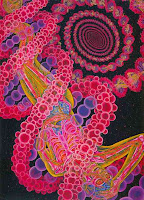" aluein" (to be out of oneself , to hallucinate ) and "toxikon" (venom). It is used to denote a rare hallucinogenic intoxication due to the consumption of the head or other body parts of a fish belonging to a group of Dream Fish , many species which are indigenous to the Indian and Pacific Oceans and the Mediterranean Sea. Because of their psychoactive effects, such fish species are refereed to as psychoactive fauna .
Ichthyoallyeinotoxism is classified as a variant of ichthyosarcotoxism ,i.e food poisoning caused by the ingestion of fish. The symptoms typically commence within few minutes to 2h after the consumption and they ussually last no longer than 36 hours. Ichthyoallyeinotoxism is characterized by generalized malaise, and a variety of CNS disturbances coordination, vivid visual and /or auditory hallucinations, nightmares, and sometimes frank delirium.The hallucinations occurring in the context of ichthyoallyeinotoxism are sometimes compared to the those occurring in LSD intoxication.The toxin/-s responsible for the medication of ichthyoallyeinotoxism are unknown. As all ichthyoallyeinotoxism fish appear to be algal grazers , it is believed that they may derived their hallucinogenic properties from alkaloids of the indole group which are chemically quite similar to LSD, and which occur naturally in certain types of algae and phytoplankton. It has also been suggested that ichthyoallyeinotoxism may be mediated by Dimethyltryptamine (DMT) ,a hallucinogenic even more potent than the indoles present in fish.
 The species most commonly claimed to be capable of producing this kind of toxicity include several species from the Kyphosus genus, including Kyphosus fuscus, K. cinerascens and K. vaigiensis. It is unclear whether the toxins are produced by the fish themselves or by marine algae in their diet, but a dietary origin may be more likely.
The species most commonly claimed to be capable of producing this kind of toxicity include several species from the Kyphosus genus, including Kyphosus fuscus, K. cinerascens and K. vaigiensis. It is unclear whether the toxins are produced by the fish themselves or by marine algae in their diet, but a dietary origin may be more likely.
Sarpa Salpa was reportedly consumed as a recreational drug during the time of the Roman empire. The fish became widely known for its psychoactivity following widely publicized articles in 2006, when two men ingested it at a Mediterranean restaurant and began to perceive many auditory and visual hallucinogenic effects. Sarpa salpa, also known as the Salema porgy, is a species of bream, recognizable by the golden stripes that run down the length of its body, and which can cause hallucinations when eaten. It is relatively common off the coasts of South Africa, Tenerife, Malta and Cyprus, but has been occasionally been found as far north as Great Britain.
Sources :
- Jan Dirk Blom -A dictionary of Hallucinations
- Haro L, Pommier P.- Hallucinatory fish poisoning (ichthyoallyeinotoxism): two case reports from the Western Mediterranean and literature review. Accessed Jan 26 2009.http://www.ncbi.nlm.nih.gov/pubmed/16615678. PMID: 16615678
- http://www.wikipedia.org
No comments:
Post a Comment